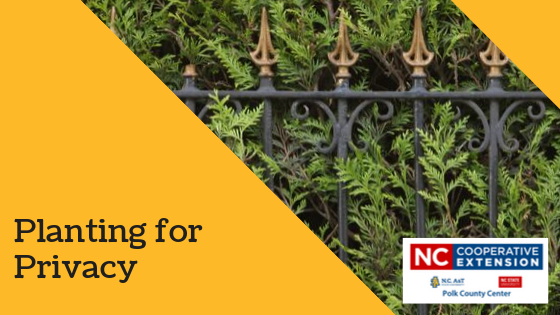Privacy Matters: Screening Plants to Consider
go.ncsu.edu/readext?625392
en Español / em Português
El inglés es el idioma de control de esta página. En la medida en que haya algún conflicto entre la traducción al inglés y la traducción, el inglés prevalece.
Al hacer clic en el enlace de traducción se activa un servicio de traducción gratuito para convertir la página al español. Al igual que con cualquier traducción por Internet, la conversión no es sensible al contexto y puede que no traduzca el texto en su significado original. NC State Extension no garantiza la exactitud del texto traducido. Por favor, tenga en cuenta que algunas aplicaciones y/o servicios pueden no funcionar como se espera cuando se traducen.
Português
Inglês é o idioma de controle desta página. Na medida que haja algum conflito entre o texto original em Inglês e a tradução, o Inglês prevalece.
Ao clicar no link de tradução, um serviço gratuito de tradução será ativado para converter a página para o Português. Como em qualquer tradução pela internet, a conversão não é sensivel ao contexto e pode não ocorrer a tradução para o significado orginal. O serviço de Extensão da Carolina do Norte (NC State Extension) não garante a exatidão do texto traduzido. Por favor, observe que algumas funções ou serviços podem não funcionar como esperado após a tradução.
English
English is the controlling language of this page. To the extent there is any conflict between the English text and the translation, English controls.
Clicking on the translation link activates a free translation service to convert the page to Spanish. As with any Internet translation, the conversion is not context-sensitive and may not translate the text to its original meaning. NC State Extension does not guarantee the accuracy of the translated text. Please note that some applications and/or services may not function as expected when translated.
Collapse ▲
This article, authored by Carl Matyac, first appeared in the Extension’s Successful Gardener publication. You can view all previous issues of the newsletter as pdf files on the Extension Gardener website.
A landscape’s basic function is to create a personal environment in the home’s outside areas. Public areas in the front of the house most often are designed to create a pleasant view from the street while the private areas, usually in the back, are often designed to be an extension of the house itself. These extensions are like outdoor rooms that can extend the living space of the home. The result can transform a backyard used for garbage cans, clotheslines and vegetable gardens into a natural setting for relaxation, meals, and entertainment.
One of the essential features of privacy areas are plants that screen undesirable sights and noises. Landscapers have overused the Leyland cypress and photinia to the point that these plants have a high probability of developing pest problems. There are many selections, however, that can serve the same function beyond these two problem species.
For year-round privacy, an evergreen hedge is the best choice. For a high screen, in full sun to partial shade, Canadian hemlock, Deodar cedar, Japanese cryptomeria, Southern magnolia, Arizona cypress, Eastern red cedar, and ‘Nellie R. Stevens’ holly are effective. Be sure to give these plants plenty of room to grow. Spacing them 10 to 12 feet apart would be about right and may even be too tight after they begin to mature. If you do not like the idea of these huge spaces between plants you can purposely overplant then cut out every other plant in five years or so.
A screen consisting of a single species in a uniform planting may not be the best choice. This type of repetition lends a degree of formality that is not always desirable. In addition, if a screen consists of all the same species, replacing a plant can be a serious problem. It is often difficult and sometimes impossible to find the desired variety of a specific size to fill in the hole created by a missing plant. Mixed borders are always more natural looking and easier to repair if a plant is lost. A slightly shorter evergreen screen could consist of Camellia japonica, Gold thread cypress, anise tree, Hollywood junipers, ‘Burford’ holly, yaupon holly, English laurel, and wax myrtle. Remember, as a rule, the junipers like more sun and the hollies tolerate shade.
Many deciduous plants also make good hedges or screens. Scotch broom, winged euonymus, forsythia, witch hazel and any number of spireas work well. Also consider some of the taller ornamental grasses such as pampas, zebra, or feather reed.
Written by Carl Matyac




